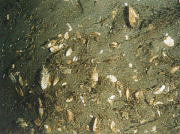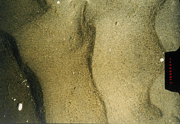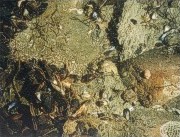

 |
 |
| Coastal and Marine Geology Program | |
| Woods Hole Science Center | |
![]() U.S.
Geological Survey Open-File Report 2005-1018
U.S.
Geological Survey Open-File Report 2005-1018
Surficial Geologic Interpretation and Sidescan Sonar Imagery of the Sea Floor in
West-Central Long Island Sound
SIDESCAN-SONAR IMAGERYThe distribution of surficial sediment and sedimentary environments within the study area were determined using tonal changes in backscatter of the sidescan-sonar mosaic, bathymetry, and ground-truth data (DiGiacomo-Cohen and others 1998; Poppe and others 1998c, Poppe and others 2000b). Areas of high backscatter typically indicate coarser grained sediment, which suggests higher energy environments, while low backscatter suggests finer grained sediment, which reflects lower energy environments. A speckled high-backscatter pattern indicates rocky areas. Some abrupt tonal changes within the mosaic may be artifacts of the mosaicking process. In addition to sediment distribution, the mosaic shows anthropogenic influences on the sea floor: shipwrecks, pipelines and/or cables, a breakwater, trawl marks from commercial fishing, lobster pots, and some nearby ship wakes, which create an acoustic artifact in the water column. Geologic FeaturesLarge areas of low backscatter occupy the central and far northeastern parts of the study area where the sea floor is smooth and protected from tidal- and storm-current regimes. As well, there are smaller regions of low backscatter spread throughout the study area. The largest areas of high backscatter are found on the tops of shoals and along the elongate bathymetric high in the northeastern part of the study area. Other regions of high backscatter occur on isolated bathymetric highs in the southeastern parts of the study area. Speckled patches of higher backscatter targets indicate rocky areas on the top of Stratford Shoal and in isolated patches near the Connecticut shoreline. The northwestern corner of the study area is characterized by sand waves appearing as areas of “tiger-stripe” backscatter (Wynn and others 2002). The sinuous crests of the waves are oriented north-south, transverse to the predominant current directions. They are spaced roughly 100-300 m apart with those in the south having wider spacing than those in the north, where the sand waves bifurcate. A seismic line across the sand-wave area shows the waves’ asymmetrical profiles. The six sand waves in this profile, which range from 1.5 m to 3.5 m high, have average stoss slopes of 1.5º and lee slopes of 3.7º. Lee sides of the sand waves on the western side are oriented to the west. Lee sides of the sand waves on the eastern side are oriented to the east. The sidescan-sonar mosaic contains some areas of moderate backscatter having elongate sinuous features of weak backscatter. These features are about 500 m long, average less than 10 m in width, and occur in depths from 9-13 m. They extend roughly perpendicular to the bathymetric contours, and most bifurcate upslope with tuning fork-like intersections. The seismic data show a smooth sea floor in the area, indicating these features have little, if any, relief. They appear to be formed by density currents of fine-grained sediments moving down-slope and, as such, may represent pathways through which sediments are remobilized and transported into the deeper basins. Whether these features are a result of local micro-bathymetry or also related to fluvial outflow from the Housatonic River is unknown.
|
 |
|
Bottom photograph showing an example of a sedimentary environment characterized by sorting or reworking. |
Fine sands that coincide with moderate backscatter on the sidescan-sonar imagery characterize areas of sediment sorting and reworking. These environments are located on the flanks of the shoals, in the southern basin, on the bathymetric highs in the southeast, along the northern shore and on the bathymetric ridge in the northeast. Areas of sediment sorting and reworking are primarily located between erosional and depositional environments (Knebel and Poppe 2000). This transitional location suggests that bottom currents, averaging less than 25 cm/s in this environment, have a restricted ability to sort and winnow coarser grained sediments (Poppe and others 2000a; Signell and others 2000), but can remobilize fine-grained material. Bands of low backscatter appear on the sidescan-sonar mosaic in some regions of this environment, which we speculate may be formed by density currents of fine-grained sediments moving down-slope. If this is true, they may represent pathways through which sediments are remobilized and transported into the deeper basins.
 |
|
Bottom photograph showing an example of a sedimentary environment characterized by coarse bedload transport. |
Environments of coarse-grained bedload transport are characterized by sand and gravelly sand and the presence of sand waves (Knebel and Poppe 2000). Two areas of coarse-grained bedload transport are located in the study area. The largest is on the unnamed shoal south of Lordship and a small area (0.2 km2) is present on Stratford Shoal. Sand waves on the unnamed shoal bifurcate towards the north, which may imply transitional dynamic conditions (Aliotta and Perillo 1987). Current speeds in environments of coarse-grained bedload transport average about 35-45 cm/s (Signell and others 2000). The lee slope orientations of the sand waves located to the east of the unnamed shoal suggest they were formed by diverging currents. Signell and others (2000) proposed that currents in this area diverge and they converge on the top of the shoal. The converging currents that result in the accumulation of sediment, which probably balances the erosion on the flanks of the shoal in strong storms and helps to keep it maintained (Signell and others 2000). Twichell and others (1998) interpreted these sediment waves as relict bedforms that are not actively moving due to the absence of smaller bedforms associated with them. However, it appears that the present current regime is, at least, preserving the sand waves.
 |
|
Bottom photograph showing an example of a sedimentary environment characterized by erosion or nondeposition. |
High and speckled backscatter areas generally coincide with coarse-grained sediments in the study area, which together indicate areas of erosion or nondeposition. These areas are located along the northern crest of the bathymetric ridge in the northeast, in isolated areas near the Connecticut shoreline, on Stratford Shoal, to the east of the shoal south of Lordship, on the bathymetric highs in the southeast, and in the center of the axial trough. Surface waves remove fine-grained sediments in shallow environments (Signell and others 2000), leaving the coarse sediments found along the shallow margins. Bottom currents produced by tides, wind, and waves (Knebel and Poppe 2000) prevent deposition on the bathymetric highs, such as Stratford Shoal, and contribute to erosion and nondeposition in constricted areas, such as the center of the axial trough between the two shoals (Signell and others 2000).
The surficial geology of the sea floor in west-central Long Island Sound interpreted from sidescan-sonar data, sediment samples, bathymetric, and seismic data show that over much of the central part of the area and in the more protected far northeastern corner the low energy on the deeper sea floor results in a depositional sedimentary environment having a bottom surface of silt and sandy or clayey silt. Areas of sediment sorting and reworking surround most of the sedimentary environments characterized by deposition. These processes reflect the transition between low- and high-energy sedimentary environments and are located where silty sand grades into sand-silt-clay. Within the sorting and reworking environments are some areas that appear to have down-slope density-flow pathways. Sand waves on the shoal in the northwestern corner of the study area indicate an environment of coarse-grained bedload transport. Isolated bathymetric highs, such as those in the southeast, the bathymetric ridge in the northeast and Stratford Shoal tend to have high-energy sedimentary environments of erosion or nondeposition with surfaces of gravel, gravelly sediment, and coarse sand. Small patches of erosion occur along the northern boundaries of the study area as well.